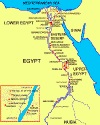|
Abydos
It
was founded by Seti I, the son of Ramesses I (ca. 1300
B.C.) and was dedicated to the cult of Osiris (the god
of the dead) the lord of Abdjou –or Abydos.
The city of Abydos
(ancient name: “Abdjw” ) flourished from the
predynastic period (4000 BCE) of Egypt’s history down
through Christian times (about 641 CE). The site of many
tombs of predynastic rulers of ancient Egypt, the area
soon grew in religious importance as a cult center for
Osiris, first during the Middle Kingdom, when such a
tomb of a First Dynasty king, Djer, was
identified as the “burial site of Osiris”, the
mythological god-king of the predynastic Egyptians
(referred to as “Osirieon”).
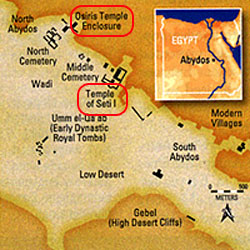
This emphasis upon Osiris
caused the city to become a pilgrimage site, as well as
a desired place for either direct burial or for the
erection of cenotaphs (monument erected in honor
of a dead person whose remains lie elsewhere). Festivals
and the passion plays of Osiris’ life and death were
performed here from about the 12th Dynasty (1985-1795
BCE) until the Christian era. One of the most
significant monuments on the area is that of the
Temple of Seti I, which is built to honor Osiris.
It is believed that Seti’s
architects had planned a classic Egyptian temple of
straight proportions, but had to change directions when
foundation work accidentally uncovered the site of
the Djer tomb, and its Middle Kingdom references as
the site of Osiris’ burial. (This issue has been
challenged in recent years, and thought now indicates
that additions of chapels may have caused the temple
plan change.)
Possibly out of piety, the
house of Seti I and Rameses II expanded
and enhanced the Osirieon site, and the passion
plays of the Osiris cult were tied into the Seti I
temple thereafter.
The Temple
The temple is called “The temple of Ramesses
I at Abydos” (Winlock). Also known as “The Temple of
Osiris at Abydos” and “the temple of art”, this temple
and its hieroglyphs date back to the 19th dynasty.
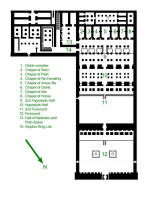
When this photograph, known
as the "Abydos Helicopter", first came to light a number
of years ago, it was immediately debunked by scholars
who claimed it had been digitally altered and that no
such relief actually existed. The problem was, those
scholarly debunking skeptics should have actually
visited the temple and looked for themselves. It turns
out that the "Abydos Helicopter" relief is very
real and has been repeatedly photographed.
Another visitor took this
photograph:
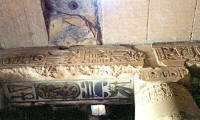
And yet another visitor took
this with his video camera:
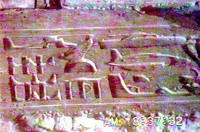
While this is not conclusive
proof that the ancient Egyptians possessed helicopters,
aircraft or submarines, it does however reveal that
there is more to the story than we have been told. The
important point here is that traditional scholars, when
confronted with factual data which did not fit their "Ancient
Egyptian Paradigm" of bread making, were unable to
see the data as it actually was, and dismissed it as a
digitally altered fraud, which turned out NOT to be the
case.
This is a classic example of
"Paradigm Paralysis" as defined by futurist
Joel Barker. The
bottom line is, when we are asked about the opinions of
"experts" or "scholars" regarding these alternative and
cutting edge technologies that are out on the
borderlands and frontiers of human thought, our answer
is: "We don't give a rip!"
The people who say something
can't be done should get out of the way of those who are
already doing it.
|
